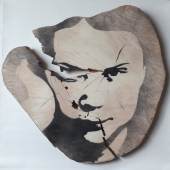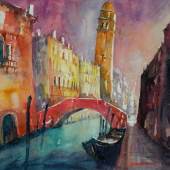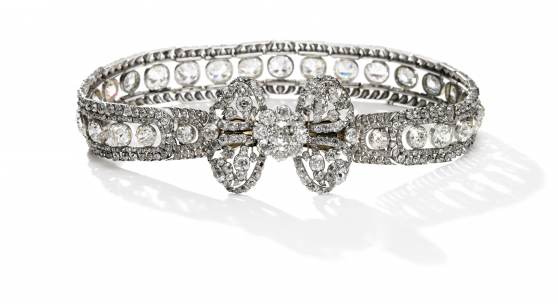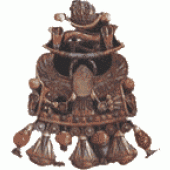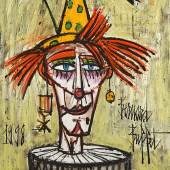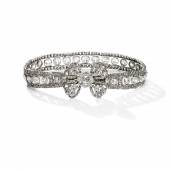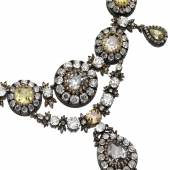Sotheby's Geneva
TWO SUPERB JEWELS OF IMPERIAL RUSSIAN HERITAGE
-
Auktion16.11.2016
Geneva, 13 October 2016 - This autumn in Geneva, Sotheby’s auction rooms will be lit up by the grandeur and elegance of the Russian Imperial Court: our sale on 16 November will feature two exceptional jewels of extraordinary historical importance. The first is a magnificent diamond necklace with a stunning and delicate bowknot clasp, thought to have been commissioned as two separate pieces by Empress Catherine II, known as Catherine the Great (1729 – 1796). It has survived centuries of upheaval and was preserved throughout the First World War in a strong room of the Kremlin. The jewel will be offered at auction with an estimate of $3- 5 million.
The second piece is one of the most important parures of antique coloured diamond jewels to appear at auction in the last 50 years. This superb suite contains stones which may have formed part of a gift by Empress Catherine I of Russia (1684-1727), wife of Peter the Great to Sultan Ahmed III to negotiate the end of the Siege of Pruth in 1711. By tradition, these extraordinarily rare jewels were then used by the Sultan Abdul Hamid II (1842 – 1918) for the present necklace, which he offered to the wife of Teufik of Egypt, possibly for the birth of the last Khedive of Egypt and Sudan in 1874. The parure will be offered in November with a pre-sale estimate of $3-5 million.
“These two stunning jewels carry with them a fascinating insight into the luxury and opulence of the Russian court. It is difficult to overstate their rarity and historical importance, and I am thrilled to be able to present them side by side this autumn.“ David Bennett, Worldwide Chairman of Sotheby’s International Jewellery Division.
OPULENCE AND CRAFTSMANSHIP: THE RUSSIAN CROWN JEWELS
Russia’s Diamond Treasure was founded in 1719 by Tsar Peter the Great (1629 – 1725), to distinguish the vast wealth of the Romanov dynasty. He is known to have commissioned numerous elaborate jewels as gifts for his wife, Empress Catherine I (1684 – 1727). Stored in the so-called Diamond Room of the Winter Palace in St Petersburg, this breathtaking collection of state jewels and regalia was added to by successive rulers, as instructed by Peter himself. The largest contribution was made by Catherine II, known as Catherine the Great (1729 – 1796), who ruled as Empress of All Russia from 1762 to 1796.
DIAMOND JEWELS “IN A CLASS OF THEIR OWN“
Thought to have been part of the Collection of Catherine the Great
The jewellery collection of Catherine the Great was renowned, and never equalled before or since in Russia. Her jewels and regalia proclaimed her power and rank as Empress and displayed the most precious materials available, crafted by the most highly skilled French jewellers such as Pauzié and Duval. This piece was originally designed as two separate jewels, crafted around 1760-80. Stylistically, the two pieces are consistent with traditional designs of the late 18th century, which would have been fastened around the neck using a ribbon or stitched directly onto clothing.
At the outbreak of the First World War, the decision was made to move the imperial treasure from St Petersburg to Moscow, and the jewels were stored in sealed cases in the Kremlin. A number of jewels – including the present necklace band and bow knot brooch - were taken to London and offered at auction at a sale of “The Russian State Jewels” in 1927. They have only been in two private collections since then, including that of the present owner.
After the war, a commission was formed to itemize and value the jewellery collection of the Romanovs from the early 17th century onwards and a catalogue, entitled Russia’s Treasure of Diamonds and Precious Stones, was published, in Russian, English, French and German, under the supervision of Professor A.E. Fersman. This autumn’s sale will include one of the very rare surviving copies of this catalogue with an estimate of $38,000- 51,000 (The Bolshevik government recalled and destroyed most copies of this catalogue, hence its extreme rarity).
A SUPERB SUITE OF IMPERIAL JEWELS
Containing stones from a jewel which may have been used by Catherine I, wife of Peter the Great to end the Siege of Pruth in 1711
Dating from the mid-19th century, this diamond parure is comprised of a necklace, a brooch and a pair of earrings. It contains stones which may have formed part of a gift presented by Empress Catherine I to the Twenty-Third Ottoman Sultan, Ahmed III (1673-1736) as part of peace negotiations with Czar Peter the Great, after the Pruth River Battles in 1711.
According to an account by Voltaire in his History of the Russian Empire under Peter the Great (1759), following days of siege, Catherine urged her husband the Czar to pursue a peaceful outcome to the stalemate. Knowing the importance of the Oriental custom according to which one should never approach a sovereign or their representatives without gifts, Catherine gathered all the jewels she had brought with her, including family heirlooms and gifts from her husband. Secretly, she sent them alongside the Czar’s letter to the Grand Vizier. Sultan Ahmed II accepted the sumptuous gift and a peace treaty was agreed between Russia and the Ottoman Empire.
-
Schmuck Geschichte - Das Altertum. Ägypten Interessant ist die Tatsache, dass es verhältnismäßig...
-
06.03.2025Sotheby’s, eines der weltweit führenden Auktionshäuser, beginnt das Jahr 2025 mit einer...
-
16.11.2016Auktion »
Sotheby's Geneva is proud to present the November sale of Magnificent Jewels & Noble Jewels. The auction features an impressive spectrum of coloured diamonds, as well as period jewels with noble provenance and fine coloured gemstones. Highlights include a historic and magnificent diamond choker, formerly in the collection of the imperial Russian family and the spectacular 'Sky Blue Diamond', a Fancy Vivid blue diamond ring weighing 8.01 carats, Cartier.
Exhibitions:
London
13–17 October
New York
4 November–6 NovemberMAGNIFICENT JEWELS & NOBLE JEWELS
Sale
Sotheby’s Geneva, Wednesday 16 November 2016 Hôtel Beau-Rivage
13, quai du Mont-Blanc, 1201 Genevatel. +41 22 908 48 00.

